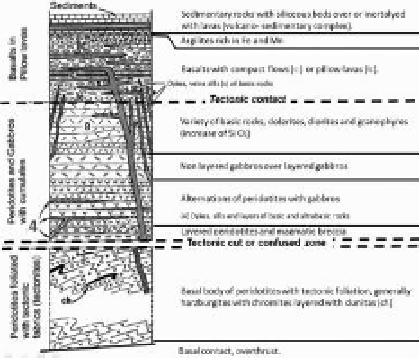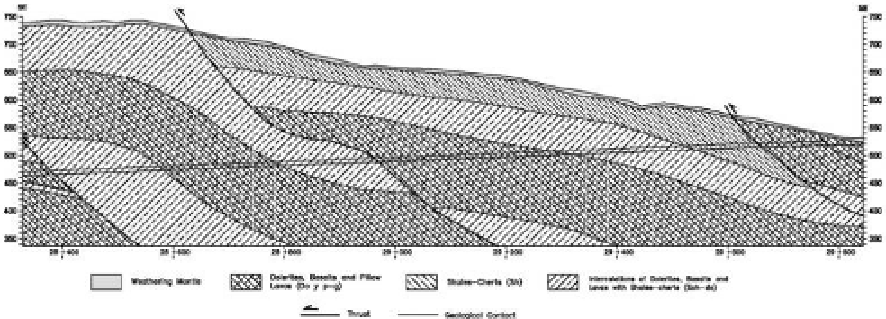Environmental Engineering Reference
In-Depth Information
Figure 1 shows the theoretical column type of
an ophiolitic comp.
interlayers within the igneous formations. They
appear slightly to moderately fractured (approxi-
mately two to three discontinuities per meter) and
slightly to very weathered. in undisturbed or nor-
mal conditions they are very strong and form steep
morphologies.
2
GeoloGical UniTs: liTholoGY
The geological units encountered along the tunnel
have been studied in the outcrops in the vicinity of
the tunnel and also in the samples recovered from
the boreholes executed along the tunnel. These
geological units are shown in Figure 2, in a longi-
tudinal geological section of the tunnel.
2.2
Gabbros and peridotites (p-g)
They consist of gabbros and peridotites mod-
erately to strongly serpentinized, with gree to
grayish-green color. They are distinguished from
other ophiolitic formations by their holocrystalline
texture. in general they are tectonized, resulting in
moderate to significant fracturation at places, while
they appear slightly weathered. The fresh forma-
tions are generally impermeable but the intensively
fractured zones exhibit increased permeability.
2.1
Basalts, dolerites and pillow lavas (Do, pla)
They consist mainly of green, grayish-green and
grayish-red dolerites and basalts. The dolerites
usually have veins of calcite and locally appear
with serpentinized discontinuity surfaces, while
the shales-cherts appear within the formation,
mostly in the locations of the tectonic zones or as
2.3
Shale and chert (Sh)
They consist of red argillaceous shales with local
interlayers of cherts, sandstone and thin-bedded
limestone. at places interlayers and lenses of ophi-
olitic formations locally serpentinized, are evident,
while continuous alternations of shales-cherts and
ophiolitic thin-bedded formations are found also
resulting in a mélange character.
The shales are usually thin bedded with thick-
ness ranging from 1 cm to 10 cm approximately,
strongly tectonized, folded and sheared with
smooth to slickensided at places discontinuity sur-
faces and slightly to moderately weathered result-
ing in significant loosening of the formation near
the ground forming mild morphological relief in
the areas where they prevail.
This formation exhibits rather low permeabil-
ity due to the dominance of the shales. Due to the
intense tectonism, the mechanical properties of
this rockmass are the lowest of all the formations
that will affect the tunnels.
Figure 1. synthetic column and a theoretical ophiolitic
comple. Foucault and Raoult (1995).
Figure 2.
Geological profile along the tunnel.

















